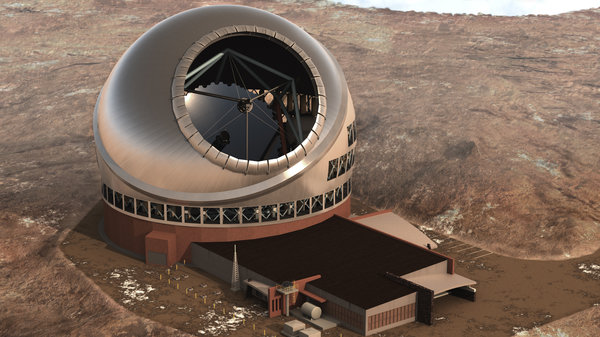
An artist’s rendering of the Thirty Meter Telescope complex. A judge recommended on Wednesday that the board issue a new permit.
THIRTY METER TELESCOPE
The stars are still in reach for astronomers who want to build a $1.4 billion telescope on top of Hawaii’s Mauna Kea.
A year and a half after the Hawaiian Supreme Court revoked the telescope’s building permit, saying that the state Board of Land and Natural Resources had cut corners in the application process, a judge recommended on Wednesday that the board issue a new permit.
The telescope’s opponents, a coalition of native Hawaiians and environmentalists, say that the proliferation of observatories on Mauna Kea has despoiled a sacred mountain and interfered with native Hawaiian cultural practices that are protected by state law.
The judge’s recommendation included the condition that the telescope’s workers and astronomers undergo “mandatory cultural and natural resources training.”
The telescope’s backers, a consortium that includes the University of California, California Institute of Technology, India, China and Canada, called the decision an important milestone, but cautioned that it was only one in a series of bureaucratic and political hurdles to overcome.
The Thirty Meter Telescope, as it is known, would be the largest telescope in the Northern Hemisphere, with a primary light-gathering mirror 30 meters, or some 100 feet, in diameter.
Astronomers say it would be able to study planets around other stars and peer into the black-hole hearts of distant galaxies with a clarity exceeding that of the Hubble Space Telescope.
It is one of three such behemoth telescopes under development worldwide. But the other two, the Giant Magellan Telescope and the European Extremely Large Telescope, are being built in Chile and thus will not be able to survey some parts of the universe only visible in the Northern sky.
Mauna Kea, Hawaii’s tallest mountain, has long been considered the best observatory site in the Northern Hemisphere and is already home to a passel of large telescopes. It is also a sacred place in Hawaiian culture and religion.
A coalition of cultural activists and environmentalists has opposed the Thirty Meter project, citing, among other things, an environmental impact statement that concluded that 30 years of astronomy had had “an adverse effect” on nature and native culture on the mountain.
At 18 stories high, the new telescope would be the biggest building on the Big Island, an industrial-scale installation, opponents say, that would violate the rules for the mountain, which is a special conservation district.
In 2015, a groundbreaking for the telescope project was broken up by protesters, who then blockaded the road up the mountain, preventing equipment and construction workers from passing.
In December of that year, the Hawaiian Supreme Court concluded that the state board had not followed due process when it approved a building permit before holding what is known as a contested case hearing where opponents could have their say.
The decision was made by retired Judge Riki May Amano, who was appointed by the land board to rehear the case. It followed 44 days of testimony by 71 witnesses over six months in a hotel room in Hilo, Hawaii.
The testimony ended in March with all the participants, pro and con, and their lawyers holding hands and singing “Hawaii Aloha,” according to Clarence Ching, a Hawaiian activist and lawyer who was there.
But the controversy is hardly over. Next the entire Board of Land and Natural Resources will hear arguments and decide whether to accept Judge Amano’s decision. Whichever side wins, the decision will be immediately appealed to the Hawaiian Supreme Court.
Even if the telescope wins in the Supreme Court, it is unclear whether the “guardians of the mountain,” as they called themselves, will relent and let trucks proceed up Mauna Kea.
Gov. David Ige has professed his support for the Thirty Meter Telescope, but he was criticized two years ago for allowing protesters to control the mountain.
Whatever the land board’s decision, Governor Ige said in a statement, “I support the coexistence of astronomy and culture on Mauna Kea along with better management of the mountain.”
In an interview last year, Edward Stone, a Caltech professor who is executive director of the Thirty Meter Telescope International Observatory, or TIO, as it is officially known, set April 2018 as the deadline for construction to begin.
If the telescope cannot be built on Mauna Kea, he said, it will be built in the Canary Islands, off the coast of Spain.
In a statement, Dr. Stone said, “TMT welcomes the recommendation that a state permit be issued, and we respectfully look forward to the next steps.”
“We are grateful to all our supporters and friends who have been with us during the hearing process and over the past 10 years, and we remain respectful of the process to ensure the proper stewardship of Maunakea.”
In a statement to The Honolulu Star-Advertiser, Kealoha Pisciotta, a leader of the opposition to the telescope (and a former telescope operator on Mauna Kea), said she was disappointed “but this is really only the beginning of a very lengthy legal battle that will most likely take us back to the State of Hawaii’s Supreme Court.”
From the New York Times
by DENNIS OVERBYE (July 27, 2017)

Leave a Reply